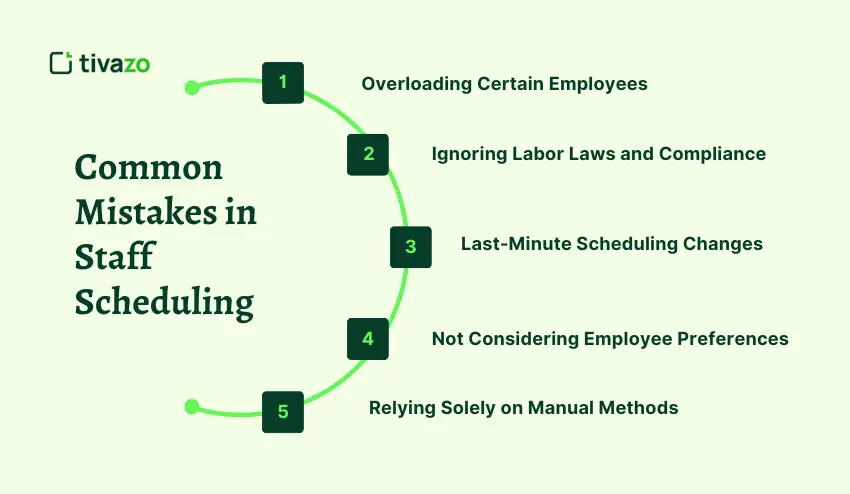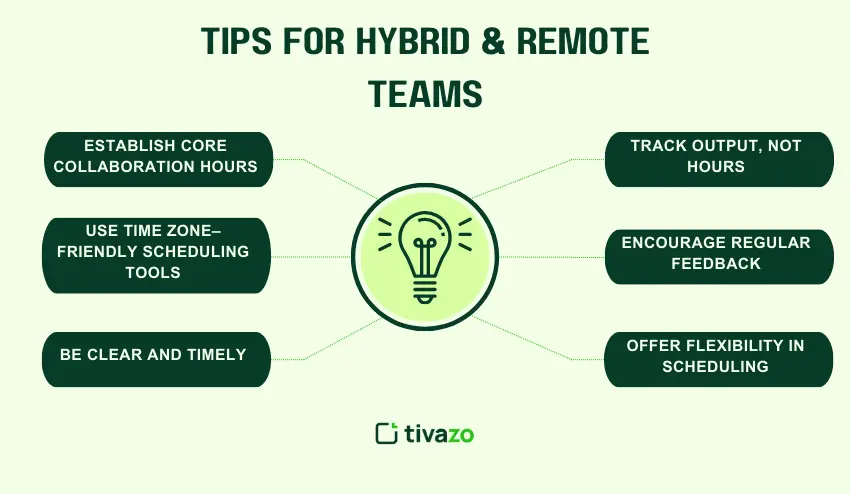Getting staff scheduling right can make or break a team’s productivity. Yet many businesses, freelancers, and even SaaS founders treat it as an afterthought until problems show up, missed deadlines, frustrated employees, and unnecessary overtime costs.
At its core, staff scheduling is about more than filling shifts. It’s about creating balance between business needs and human needs. When done well, it builds trust, reduces stress, and keeps everyone aligned. When done poorly, it leads to burnout and turnover.
In this guide, we’ll break down what staff scheduling is, why it matters for different types of leaders, the strategies that work in 2025, and the tools that can make the process easier.
What is Staff Scheduling?
The process of planning and assigning work shifts in order to have the right people in the right place at the right time is referred to as staff scheduling.
It might seem that it is easy at first sight, just name-matching to shifts. However, in reality, it is a matter of the business need and the availability of the employees, the legal needs, and personal tastes. To the HR managers it is a means of ensuring that things run smoothly. In the case of freelancers, it concerns the ability to cope with the work of clients without exhaustion. And to SaaS founders or team leaders, it makes the various time zones and roles of the projects run well.
Consider personnel scheduling as a plan and a calendar. It is not merely filling slots but building structure such that people are aware of what is expected, work is evenly distributed, and there is reduction of surprises.
Why Staff Scheduling Matters for Today’s Workforce
Good staff scheduling goes beyond keeping a calendar organized. It directly affects productivity, morale, and even retention. When schedules are clear and fair, people work better together and businesses save time and money.
For HR Managers
HR managers face the challenge of compliance, labor laws, and employee satisfaction all at once. A well-planned schedule ensures legal requirements are met, reduces overtime costs, and makes teams feel valued.
For Freelancers
Freelancers may not have “staff” in the traditional sense, but they juggle multiple clients and deadlines. Scheduling allows them to block time for different projects, avoid overbooking, and deliver consistently.
For SaaS Founders
Founders often scale teams quickly across time zones. Without structured staff scheduling, projects stall and miscommunication spreads. Smart scheduling helps align distributed teams, keeps tasks moving, and builds trust in remote setups.
For General Leaders
Leaders across industries benefit from predictable schedules. Clear planning reduces last-minute chaos, lowers stress, and ensures everyone knows what they’re accountable for. The result is a healthier, more productive workplace.
Types of Staff Scheduling
Not every team operates in the same manner and that is why the staff scheduling techniques are not the same. The process of selecting the type is based on the size of your team, industry, and style of work. The most common are the following:

1. Fixed Scheduling
This is the easiest type of scheduling. The same shifts are worked by employees or team members on a weekly basis. As an example, a 9-5 Monday to Friday arrangement. It is stable yet may not be flexible to changes in demand.
2. Rotating Shifts
In this case, the shifts are rotated on a predetermined schedule, morning, evening, night, and rotated among the employees. It is fair but may be harsh to the health of the employees unless handled effectively.
3. On-Call Scheduling
The employees will be arranged on-call and will be called in when necessary. Though it is a handy tool in industries whose demand is uncertain (such as healthcare), it may be frustrating to employees when applied excessively.
Using scheduling software can make scheduling hassle-free, especially when teams are working out in the field. For example, software for pest control businesses can automate shift assignments, track team availability, and simplify on-call rotations, reducing administrative overhead and keeping everyone aligned.
4. Remote & Hybrid Staff Scheduling
As the number of teams operating online increases, the schedules have to include the various time zones and flexible working hours. This type is centered on core overlap hours and freedom of remote workers.
5. Freelance or Project-Based Scheduling
Contract workers or freelancers tend to schedule their time on client projects. This kind of type focuses more on deadlines and deliverables rather than definite shifts. It is effective when there is clarity in timelines and communication.
Key Strategies for Effective Staff Scheduling
Effective staff scheduling does not occur by chance. It is the product of an effective system where business and employee needs are balanced. The following 7-step model can be used immediately:
1. Define Needs and Availability
Begin with mapping your business demand. What roles should be covered and when? Compare with the availability of employees to ensure that you are not giving hours that they are not available to work.
2. Use Scheduling Tools or Software
Scheduling manually on paper or spreadsheets is soon messy. Such tools as Homebase, Deputy, When I Work, or Connecteam make it easier, minimize mistakes, and save time per week.
3. Factor in Compliance and Labor Laws
Violation of labor regulations is subject to expensive fines. When staff scheduling, always ensure to check local rules regarding breaks, maximum hours and overtime.
4. Balance Workloads Fairly
Share work equally to avoid burnout. Working too many employees makes them bitter and turnover is high. Fairness keeps morale high.
5. Communicate Early and Clearly
Post schedules beforehand to allow staff to organize their lives. Rush-hour problems bring about stress and distrust between the teams and the managers.
6. Track and Adjust in Real-Time
Schedules aren’t set in stone. Identify problems such as absenteeism or overtime before they get out of control using real-time data.
7. Gather Feedback and Improve
Sometimes employees are aware of the best things. Request feedback regularly and then optimize your staff scheduling process to accommodate the business as well as the staff.
Common Mistakes in Staff Scheduling (and How to Avoid Them)
Even seasoned managers may commit scheduling mistakes that influence productivity and morale. The pitfalls and their avoidances are as follows:

1. Overloading Certain Employees
Providing too many shifts to some employees results in burnout. Solution: Keep time and shift equally.
2. Ignoring Labor Laws and Compliance
Failure to observe local labor regulations can attract fines. Remedy: When preparing schedules, it is always important to remember to look at the maximum hours, breaks, and overtime regulations.
3. Last-Minute Scheduling Changes
Sudden and frequent changes in the working process irritate the employees and disrupt their working process. Resolution: Release of schedules in time and any alterations communicated.
4. Not Considering Employee Preferences
Inattentiveness to availability or desirable shifts is demoralizing. Resolution: Seek feedback on behalf of the employees and utilize it in the process of schedule creation.
5. Relying Solely on Manual Methods
Spreadsheets or pen-and-paper procedures lead to errors and missed shifts. Solution: Schedules can be tracked in solution software or templates, and automated.
These mistakes may be prevented to ensure a just, predictable, and efficient working environment of the staff as well as managers.
Cost Implications of Poor Scheduling
Ineffective staff scheduling does not only aggravates the employees, but it also has a direct effect on the bottom line of the business. These costs can be broken down as follows:
1. Lost Productivity
In case of schedule mismatch, employees can work during the wrong hours, leaving gaps in the coverage or even idle time. Employees who are overworked also commit more errors thus reducing efficiency further.
Example: A retail store that had uneven coverage of shifts recorded 15 percent less sales per peak hour because of understaffing.
2. Overtime Expenses
When the schedules do not match the demand, the employees tend to work overtime to cover gaps. This adds unnecessary payroll expenses and may add unnecessary budgets.
3. High Employee Turnover
Leaving behind unfair or unpredictable schedules cause burnout and dissatisfaction. Finding new staff is costly, and training and onboarding new staff is costly, which may be more than the cost of appropriate scheduling in the short run.
4. Customer Service Impact
The understaffed shifts imply slower service, slower response, or failure to meet deadlines. This may damage brand image and diminish customer loyalty, which will eventually impact on income.
5. Administrative Overhead
Manual scheduling is time-consuming for the manager. This decreases the attention of strategic activities such as workforce planning or process improvement.
Example: A healthcare clinic, where the paper schedules were used, had to spend an average of 12 hours per week to resolve conflicts and correct errors. Immediately they changed over to automated scheduling software, and they cut this to 3 hours, and time was saved to attend to patients.
Lesson Learned: Intelligent scheduling habits will save wasted labor expenses, turnover, productivity, and employee satisfaction.
Actionable Checklist for Better Staff Scheduling
This 9-step checklist will help you to make efficient, fair, and stress-free schedules:
- Evaluate Team Requirements- Find positions, busiest times, and dead zones.
- Check Employee Availability- Collect schedules, preferences, and constraints.
- Choose the Appropriate scheduling approach- fixed, rotating, on-call, remote, or project-based.
- Use Tools or Templates – Automate shifts using software or templates.
- Factor in Compliance – Make sure that labor requirements and break requirements are addressed.
- Balance Workloads- Shift rotations should be fair to prevent burnout.
- Communicate effectively – Publish schedules early and emphasize changes.
- Track Attendance and Adjust- Track real hours and change corrections on the fly.
- Get Feedback- Get employees to say what is working and keep on improving the scheduling.
This checklist will help to make sure that staff scheduling will contribute to productivity, minimize stress, and establish trust between teams and management.
Tips for Hybrid & Remote Teams
The process of scheduling hybrid and remote teams is associated with its own challenges: time zone differences, flexible working schedules, and remote communication barriers. The following is a closer manual on how to manage them:

1. Establish Core Collaboration Hours
Establish a set of hours that all are supposed to be free to meet or discuss matters as a team. As an example, 10 AM to 2 PM across time zones would make sure there is an overlap and nobody will be compelled to work odd hours. This assists teams to coordinate in a more efficient way and maintain flexibility.
2. Use Time Zone–Friendly Scheduling Tools
Multi-time zone manual scheduling tends to cause confusion and deadline failure. The current scheduling programs, such as When I Work or Deputy, are able to automatically accommodate the location of each employee, and it is simpler to allocate shifts and monitor availability.
3. Be Clear and Timely
Transparency is critical for remote teams. Publish schedules at least two weeks in advance and use notifications to alert employees of any changes. This reduces last-minute stress, ensures coverage, and allows staff to plan personal commitments effectively.
4. Track Output, Not Hours
Strict clock-in rules are not necessarily effective in hybrid systems when used in comparison to results tracking. Focus on the deliverables and key performance indicators (KPIs) as opposed to the actual hours of working. This fosters trust, flexible working hours, and ensures productiveness.
5. Encourage Regular Feedback
The difficulties remote and hybrid workers may have to face can be overlapping deadlines or conflicting schedules. Periodical surveys or visits to the team may help the managers to identify the problems at the initial phase and re-organize the schedule to improve the performance and motivation.
6. Offer Flexibility in Scheduling
Provide an opportunity to employees to change shifts or change starting and finishing time. Self-service tools allow members of a team to make basic changes themselves, thus relieving the administrative burden and empowering personnel.
Scenario: A SaaS firm that has 30 remote workers adopted flexible core hours and automated scheduling. Three months later, the teamwork was enhanced, the number of missed deadlines decreased by 20 percent, and the level of employee satisfaction went up.
Staff Scheduling Metrics & KPIs
It is important to measure the effectiveness of your staff scheduling to enhance efficiency and employee satisfaction. Monitoring the key metrics, managers can detect the problems, schedule the work and make decisions based on the data.
Key Metrics to Track
- Overtime Hours
- Excessive overtime may indicate understaffing or improper distribution of shifts.
- Overtime monitoring assists managers to alter the schedules to avoid burnouts and minimize labor expenses.
- Shift Coverage Percentage
- Indicates the number of shifts that are staffed and those that are unfilled.
- Makes sure that all the important positions are covered and the business runs well.
- Schedule Adherence
- Monitors the attendance of employees in terms of reporting on time and going on the shifts.
- Helps find out the problems of reliability and revise the staffing plans.
- Employee Satisfaction
- The surveys or feedback may show the fairness and manageability of schedules.
- Employees who are happier will work more and are less likely to quit.
- Absenteeism & Last-Minute Changes
- Regular absences or last minute replacements are a sign of schedule clashes or dissatisfaction.
- Monitoring such trends assists in perfecting the future scheduling and enhancing communication.
Monitoring such KPIs helps organizations to make informed decisions, enhance productivity, and provide better working environment to the employees.
The Future of Staff Scheduling
The art of staff scheduling is changing at a high rate due to the technology and the transformation of work. In the future, there are a number of trends that are influencing the way managers, freelancers, and leaders will design changes in 2025 and beyond.
1. AI & Machine Learning
History of staffing can be analyzed using artificial intelligence to forecast the highest demand and optimize the assignments of shifts. The machine learning models keep improving, and they assist managers to make smarter scheduling decisions with minimal manual work.
2. Mobile Scheduling Apps
The use of mobile applications enables the employees to view, swap and update shifts in real-time. Remote teams and freelancers are particularly in need of this flexibility to allow smooth communication and reduce last-minute disputes.
3. Predictive Analytics
Predictive analytics assists companies to estimate the staffing requirements in terms of historical trends, seasonal and business objectives. This eliminates overstaffing or understaffing and enhances the efficiency of operations.
4. Integration with Other Systems
The contemporary scheduling software is becoming more and more interconnected with the payroll, human resource, and performance management systems. This gives a comprehensive perspective on the workforce management and simplifies the administrative work.
With these trends, organizations will be able to develop smarter, efficient and employee-friendly schedules and be on the path to success in the fast-changing work environment.
Conclusion
Staff scheduling is not only about giving the shifts but it is also a strategic process that influences the productivity, employee satisfaction and the overall performance of the business. Knowing the types of scheduling, monitoring central metrics, using contemporary tools, and implementing best practices, managers, freelancers, and leaders can develop reasonable, effective, and adaptable schedules.
Smart staff scheduling will help in minimizing overtime, burnout, and workflow in the teams. Regardless of whether you are leading a small team, a remote workforce, or a developing company, the strategies will assist your company to remain organized, motivated, and productive.




